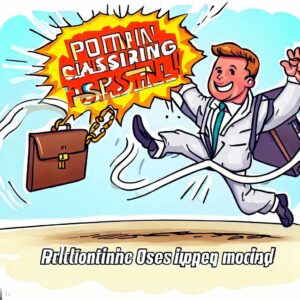By harnessing consultative closing and utilizing mini-steps for success, sales expectations can be met. Consultative closing is a sales technique that prioritizes building strong relationships with customers by understanding their needs and providing tailored solutions. By implementing consultative closing strategies, managers can train their sales teams and improve overall sales performance. One effective method is the use of Mini-Steps, which break down the sales process into manageable stages. This approach helps salespeople develop a clear understanding of each step and enables managers to track progress and make informed decisions. Additionally, consultative closing techniques have a positive impact on forecasting and planning, providing managers with accurate insights into the buying process based on customer interactions.
Enhancing Sales Performance Through Consultative Closing Techniques and Mini-Steps

Consultative closing is a sales technique used to help customers make informed purchasing decisions. It involves building relationships with customers, understanding their needs, and providing solutions that meet those needs. Managers can use consultative closing to train their sales teams and improve their overall sales performance.
One way that managers can use consultative closing is by creating Mini-Steps. This is a group-learning exercise that involves bringing everyone together in the same room to lay out the steps involved in closing a sale. By doing this, managers can ensure that everyone is working from the same playbook and has a clear understanding of the process.
Mini-Steps can be broken down into several stages, starting with identifying the customer’s needs and determining how the product or service being sold can meet those needs. Other key steps include presenting the product or service, handling objections, and closing the sale. By breaking down the sales process into these smaller steps, managers can help their salespeople develop a clear understanding of what needs to happen at each stage to move the sale forward.
When using Mini-Steps, it’s important for managers to keep in mind that this is not simply a one-time training exercise. Rather, it should be an ongoing process that is regularly reviewed and updated based on feedback from the sales team. In addition, managers should encourage their salespeople to share their own experiences and insights so that everyone can learn from each other.
Another key benefit of consultative closing is its impact on forecasting and planning. Traditionally, salespeople provide verbal interpretations of where they think prospects are in the buying process. However, by using consultative closing techniques, managers can gain more accurate insights into where prospects actually are in the process based on their actions. This can make a huge difference in forecasting sales and planning for future growth.
To achieve this level of accuracy, managers need to encourage their salespeople to track every interaction with potential customers. This includes phone calls, emails, meetings, and any other touchpoints. By tracking these interactions, salespeople can gain a better understanding of where the prospect is in the buying process and what actions need to be taken to move the sale forward.
In addition, managers should regularly review this information with their sales team to identify trends and patterns. For example, if a particular type of customer tends to respond well to a specific approach or messaging, this can be used to refine the sales pitch for that audience.
Overall, consultative closing is a powerful technique that can help managers improve their sales team’s performance. By creating Mini-Steps and encouraging their salespeople to track every interaction with potential customers, managers can gain more accurate insights into the buying process and make better-informed decisions about forecasting and planning for future growth.
Embracing Clear Pipelines: Leveraging Mini-Steps for Improved Business Performance

The concept of “clear pipelines” is becoming increasingly important in modern business. Essentially, this refers to the need for management to have a comprehensive view into the inner workings of their organization at all times. By doing so, managers are better equipped to identify emerging opportunities, as well as potential problems, before they spiral out of control. One way to achieve clear pipelines is through the use of Mini-Steps.
Mini-Steps are essentially small, tangible action-steps that are attached to each stage of a pipeline. By providing managers with these actionable items, they can more effectively monitor progress and identify any potential issues before they become major problems. This is especially useful during slow months or when there are concerns about a particular seller’s performance.
To start embracing Mini-Steps and clear pipelines, managers can take several steps. First, it is essential to communicate clearly with the sales team that a new level of accountability and reporting is being put into place. This new system is not just for salespeople but for management and the organization as a whole. It is designed to benefit the client, salespeople, and the overall business.
Next, managers should explain to the sales team that there will be occasional debriefings after a sales call. During these debriefings, the manager will hold the salesperson accountable for providing realistic answers that align with the expectations they set with clients. By doing so, managers can ensure that their sales team is operating ethically and transparently, which is essential for building trust with clients and maintaining a positive reputation in the market.
Another way to embrace Mini-Steps and clear pipelines is by using data more effectively. Modern businesses generate massive amounts of data on a daily basis. However, too often, this data is siloed and not used effectively to inform decision-making. By implementing tools such as data analytics software, sales teams and managers can gain real-time insights into key metrics such as conversion rates, average deal size, and lead generation. This information can be used to identify patterns and trends, as well as areas for improvement.
Finally, it is essential to cultivate a culture of continuous improvement within the sales team. This means embracing the concept of “NO,” or the ability to say no to deals that are not a good fit for the organization. Too often, sales teams are incentivized to close deals at any cost, even if it means sacrificing long-term profitability or customer satisfaction. By encouraging salespeople to prioritize quality over quantity, managers can ensure that the organization is aligned around its core values and mission.
Building clear pipelines and embracing Mini-Steps is essential for modern businesses that want to stay ahead of the competition. By providing managers with actionable steps they can use to monitor progress and identify potential issues early on, organizations can improve their overall performance and build trust with clients. To embrace these concepts, managers should communicate clearly with their sales team, use data more effectively, and create a culture of continuous improvement centered around the concept of “NO.”
Embracing “NO” in Sales: Turning Rejection into Growth Opportunities

As a salesperson, it can be challenging to face rejection from clients. When you get a “NO” response, it’s essential not to overreact and start attacking the client with suggestions on what they need to do to change their mind. Instead, take a moment to listen to their reasons for saying “NO,” give them positive affirmation for making a decision, and then discuss the issues that led to the negative response.
It’s important to remember that hearing “NO” doesn’t mean the end of the road. It could merely be a temporary setback or an opportunity to learn more about the client’s needs and preferences. By embracing “NO,” you can use it as a stepping stone towards getting closer to the ultimate goal of closing the deal.
However, accepting “NO” isn’t always easy. Salespeople may feel discouraged or worried about losing the client. That’s where good managers come in – they provide tough love and support to help the sales team navigate through the process. A manager’s job is to go into the “Ugly Pond” and address the underlying issues that led to the negative response. By doing so, they can help bring back NO clients to YES and ensure that the team grows and learns from every experience.
The key to embracing “NO” is understanding how to follow through with the process. It’s vital to have an action plan in place and know how to communicate to the client whether the “NO” is temporary or final. The goal is not to give up but to keep pushing forward until you reach the desired outcome.
It’s important to note that “MAYBE” is the real killer. When a client says “MAYBE,” it creates uncertainty, which can be frustrating and challenging to navigate. In contrast, when a client says “NO,” it provides clarity and allows you to focus on addressing the issues that led to the negative response.
Facing rejection in sales can be tough, but it’s crucial to embrace it and use it as an opportunity to learn and grow. When a client says “NO,” take the time to listen and understand their reasons before developing an action plan to address the issues. Remember that “NO” is not a life sentence, and with the right approach, you can turn it into a valuable experience that brings you closer to achieving your goals. So, embrace “NO,” and don’t let “MAYBE” be the killer of your sales success.
Conclusion
Consultative closing is a powerful sales technique that enables managers to enhance their sales team’s performance. By implementing Mini-Steps and encouraging the tracking of customer interactions, managers can gain valuable insights into the sales process, improve forecasting accuracy, and plan for future growth. The continuous review and refinement of Mini-Steps based on feedback from the sales team ensure ongoing improvement. Ultimately, consultative closing facilitates informed purchasing decisions, strengthens customer relationships, and contributes to the overall success of the sales team and the organization as a whole.
